
Atlas F1 Technical Writer
The volatile events over the Australian weekend left the teams with less than desired data about their cars and their rivals'. Nevertheless, some important information was collected during the first GP of the season, and Atlas F1's technical writer Craig Scarborough is here to analyse the weekend from a technical and strategic point of view
Weather
The weather dominated the amount of time the teams had for productive track running, the Friday session started with a wet track, dried and then rained until the end of the session. This, plus the track's slippery, unused surface meant the data the teams collected from the limited running would not be comparative to the conditions expected later in the weekend.
Sunday was more of the same with a wet track for the warm-up, and although the circuit was dry for the race, the threat of rain during the race worried the teams' strategists, who needed to decide on a set-up and fuel strategy to counter a potential change in the conditions.
Set-up for wet tracks revolves around softening the car's damping and springs, raising the ride height to clear the plank from the ground, and softening the engine and transmission setting to smooth the power delivery and gear change. Furthermore, the teams add more downforce to press the tyres to the wet track.
Strategy for part-wet races depends on the likelihood of rain and then the time and amount of rain expected. Usually the safe strategy is for the team to fill up the cars with enough fuel to allow a longest possible run in case the rain should fall just after a scheduled pitstop and force the driver to make an extra stop.
The lack of track running affected the teams who wanted the full set of hour long sessions to learn the car, because in part wet conditions the team prefer to keep a dry set-up on the car ready for the track to dry in order to post some fast lap times. Although the teams always venture out to test the car's response in the wet, this running is rarely representative, as wet conditions are ever changing with different amounts of rain falling and water 'standing' on the track.
While it is not the role of this review to argue who was to blame for the accident, the causes and results are interesting.
Both Ferraris had poor starts - Rubens Barrichello moving over to a defensive inside line towards the first corner. The McLarens, Williamses and Renaults all had equally good stats, and Ralf Schumacher was able to get a draft right up behind the Ferrari of Barrichello. But the Ferrari moved over to take a wider line into the corner and Ralf's right wheel and nose hit the F2001's rear. The impact ripped off Ralf's front wing and the wheel-on-wheel contact launched the front of the Williams car into the air, with the flat underside of the car catching airflow and flipping nearer to vertical.
The Williams car then fell to the ground rear end first, before landing on all four wheels and running over the gravel into a tyre barrier. The car was lucky not to flip over - fortunately the loss of the front wing reduced the floor's surface area, which otherwise may have caused a "flip". The car remained largely intact - despite the large frontal impact with the Ferrari and the impact with the ground - with the nose cone and all four wheels being retained as designed.
While in the air, the on-car camera caught the unexpected sound of the engine "blipping" - although what caused this isn't clear. Perhaps with Ralf's foot off the pedal the car's electronics blipped the throttle to keep the engine ticking over.
The rear end of the Ferrari was largely intact and the car span harmlessly to a halt after the accident.
The following pack all dodged to avoid the accident and various cars spun or were hit by other cars, in all nine cars were eliminated by the accident. Both Saubers were out with Nick Heidfeld - out of control on the grass - collecting several cars still on track.
Tyres
With the mixed track conditions, the tyre companies had a hard weekend, as conditions varied from a fully dry track to a cooler drying track, to damp (intermediate), and to fully wet conditions. There were never the usual hot conditions - this has been the first very wet race weekend in Melbourne, and the teams and tyre companies didn't have any data to fall back on.
The early running suffered the expected "green" dry track conditions and the on-off rain washed away any rubber laid down. Strategy-wise, all teams opted for a single stop, meaning less dry weather tyres needed to be scrubbed in, but the teams also scrubbed in various combinations of wet weather tyres in case of rain.
During the race, getting the dry weather tyres up to temperature was an issue and then preventing the tyres going off. This was especially important for the front runners, who were locked in various on-track battles, with several failed overtaking manoeuvres resulting in either a locked wheel and a flat spotted tyre, or running off the road and picking up dirt on the tyres. Michael Schumacher later admitted that "tyres influenced our battle" at the 2nd re-start. "I was having problems getting enough grip from my tyres and it was a close fight with Montoya, but then the situation reversed and my tyres got better as his got worse," the German said.
Team by Team
Ferrari
Running their F2001 car from last year, the team had over a year's worth of data and set-up knowledge, and this showed when they were able to top the time sheets of every session by up to a second - such was the advantage of knowing the car's set-up in differing conditions.
While outwardly identical to the car that ran at the end of last year, there were in fact three brand new F2001 chassis manufactured for the race. The chassis retained the old exterior surface shape, but the construction of the chassis mainly in the lay up of the carbon fibre is based on the technique used for the F2002, which saves up to 5kg over the older method, all adding to the amount of the all-important ballast the team can use to balance the chassis. The car also sported new electronics and an engine with components from the new engine.
The car briefly ran a new front wing before resorting to the older format, however the team ran a brake light all weekend, the rear lamp lighting whenever the car slowed either from braking or lifting off - a first in modern F1 and a change expected to be mandatory in the near future.
With the car over a year old and a new car ready to run, the team appeared to have no secrets, as the car sat in the pits without wheels, showing off the suspension and complex brake ducts. The car ran in a medium to high downforce format, with a triple element front wing and bi-plane arrangement for the rear wing. The sidepod sported the familiar winglets ahead of the cooling outlets.
For a race set-up the team lacked straight-line speed, preferring to have a higher downforce wing set up. Michael Schumacher even added more downforce to the car before joining the grid, and the car was more nimble through corners, visibly so when chasing Juan Pablo Montoya and Jarno Trulli through the last corner before the pit straight.
Williams
Although hard to be conclusive, the Williams team had a slight edge over McLaren for most of the weekend - with the advantage of a year of experience of the Michelin tyres, especially running in colder conditions.
The car appeared much as it has since the launch - the front wing was a design reminiscent of a 2001 profile, with two elements almost parallel to the ground with no discernable dip in the middle or outer edges. The secondary flap had a deep section across almost all of its width with only a small cut out under the nose. The rear wing was a conventional bi-plane layout, and the sidepods ran the pair of flip ups ahead of the rear wheels, although the sidepods did not need to run with the chimneys - such was the climate.
Whether due to the tyres or a Williams trait, the car seemed to lack braking power. Michelin have developed their tyres to improve longitudinal traction to gain grip for braking and acceleration, but chief engineer Sam Michael commented: "this is a very hard circuit on brakes and we are straining other components on the car as well." Throughout the weekend the team ran their brakes very hot and despite larger brake ducts, Juan Pablo Montoya had a small brake fire when he stopped in the pits on Saturday.
In the race itself, Ralf Schumacher was involved in the first corner accident and later said "I felt like a passenger on an aeroplane and I was really lucky because I ran off in the right area and didn't trip around." Montoya had a better race, fighting with Michael Schumacher until his tyres' performance and some misjudged braking on oil at turn 3 lost the fight. But his car was reliable and he retained his second place.
McLaren
More than any other car, the McLaren ran with several new visible parts in Melbourne, with the most obvious being a new triple element front wing. The McLaren understeered last year with its more conservative front wing design, and Adrian Newey has followed the Ferrari and Jaguar route and gone for the maximum number of elements allowed. The wing featured a deep curve across its length to allow the centre section to sit closer to the ground, as allowed in the regulations.
The sidepods were also updated in two ways - the first a long "flip up" attached half way up the sidepod in front of the rear tyres. These flip ups both direct around the rear tyres but also help to create a low pressure area above the floor of the car, preventing air spilling under the floor and upsetting the downforce created by the diffuser.
The car ran with a bi-plane layout rear wing to compliment the downforce created by the newly developed bodywork. With all the extra changes the car still displayed some understeer - especially in the hands of Kimi Raikkonen, who had a lot of low speed understeer through the last corner, which left him struggling to get in the slipstream and overtake Juan Pablo Montoya in the race. But as with Williams, some of this may be down to tyres.
While most teams like to tailor the cockpit to the driver, most teams also create only a single steering wheel design. McLaren have opted to run two different wheels designed for the drivers, although the general shape and switch layout is the same. David Coulthard's steering wheel is cut from a flat sheet of carbon fibre, while Kimi Raikkonen's wheel is moulded in carbon fibre, and wraps around the exposed wiring is seen on David's wheel.
The teams' performance was close to Williams all weekend and the crossover to Michelin tyres hasn't hampered the team too much. In the race, David Coulthard's better start and avoidance of the Barrichello/Schumacher crash left him in the lead and unchallenged for a while. Then, Coulthard explains, "my car developed a gearbox down selection problem and when the Safety Car pulled in it put itself into neutral which caught me out and I went off the track. I managed to rejoin but the problem continued and eventually the car jammed in sixth gear and that was the end of my race."
Jaguar
During the Friday and Saturday practice sessions, Jaguar were clearly a team with car trouble. As Jaguar frankly put it: "The new Jaguar R3 is suffering from a severe lack of aerodynamic downforce." This problem is complicated by the fact that after initial testing the car had several mechanical design failings, and while these have been worked on, the aero side had to wait - hence the downforce problems. Niki Lauda said that despite new parts being used in Melbourne these problems were expected; more aero developments are coming and within the next month the new UK-based wind tunnel will replace the current California wind tunnel.
The car improved with different set-ups over the weekend, and a downbeat Eddie Irvine explained the situation by simply saying "the car was slow and didn't handle on Friday," and then on Saturday "handled but was still slow," which of course worried him.
Both cars survived the opening lap and left Irvine in fifth place, which was promoted to fourth after Coulthard's problems. Pedro De La Rosa suffered an electrical engine problem, which took time to fix in the pits and he rejoined and completed the race several laps down. The result was better than the team could have expected and at least reliability is not one of their major problems.
Minardi
Alex Yoong enjoyed a good weekend but had several off track excursions. In the race he suffered with a wet weather set-up and a long brake pedal, but he still finished the race classified 7th. While Alex's race result alone would have been a huge boost for the team, Australian Mark Webber enjoyed an even better weekend - qualifying inside the top twenty and avoiding the first corner problems to run to an eventual fifth despite differential problems and what he described as "bit of drama at the pitstop, when the refuelling flap didn't open." He also fought off a charging Mika Salo to retain his position and score the first points for the team in over two years. The Asiatech engine also ran reliably, giving the team confidence for the races ahead.
Toyota
The team went into their first ever F1 weekend knowing problems were expected. Driver Mika Salo summed it up by saying: "we knew we would struggle because of a lack of downforce and lack of experience with the tyres."
The team have worked on the details of the car constantly since the launch, and one small visible detail was the flip up on the outside of the front wing endplate: rather than the long single piece, the team ran two smaller flip ups. These small devices add a little downforce but also shape the important flow off the endplate trailing behind the front wheel.
In the race, Allan McNish was among the first corner casualties on his F1 debut, while Mika Salo "was hit on the first lap and had to change the track rod at the rear," as he later explained himself. He rejoined the race and chased down fifth place from Mark Webber before a small spin dropped him back, but still a points finish for the team's first race is an excellent result.
Sauber
Sauber rightly expected a good result from the Grand Prix, Friday and Saturday timed sessions leaving both drivers in the top ten. The car ran in a familiar spec and both drivers felt happy with progress and suffered no technical problems.
In the race, however, Felipe Massa was in the pack that got held up in the first corner accident and was hit by several other cars. While trying to avoid stalling and staying in the race, Massa floored the throttle and spun the rear tyres, making the melee appear even more dramatic, however the damage to the car led to his retirement.
Nick Heidfeld took avoiding action early, but spun on the wet grass and went into the pack, also spinning his wheels in the hope of getting back into the race. His car was also too damaged to continue, and so both Saubers were wiped in the first corner.
Renault
Despite high confidence, the team never showed their potential over the weekend. The car appeared much as the version run in testing - new front wings and endplates were evident and similar to the final 2001 versions.
BAR
A new level of confidence was evident in the team, and both drivers reported good handling from the car throughout the weekend.
Although largely in the launch spec, the car ran a new exhaust system all weekend - the only visible part of the exhaust is where is protrudes through the top of the sidepod. On the launch car this was set into the bodywork and the pipe lying almost horizontal. The new version, on the other hand, had the exhaust extended much further from the bodywork while still at the same angle. No explanation was given for the change - either it was a new system developed by Honda with longer pipes to improve the much criticised power output of the engine, or the extended pipe was to clear the hot exhaust flow from the carbon fibre suspension.
In the race Olivier Panis retired at the first corner with damage, leaving Jacques Villeneuve still running until the rear wing broke off on the 27th lap. Villeneuve said it was "possibly because it was faulty or maybe it was something that we didn't pick up in testing," perhaps suggesting the new exhaust had some part in the failure.
Jordan
It was a busy weekend for Jordan. The car did not feature revised exhaust as the similarly engined BARs ran, and the car was visibly identical to the one testing at Silverstone before flying out to Australia. The car wore cooling chimneys all weekend on the sidepods and retained the angled front wing mounts used in the later pre-season tests.
Takuma Sato on his F1 debut weekend also had a good Friday, but then on Saturday morning he had a big accident in turn 14 which, in his words, "was because of a problem we had with the automatic down-shifting which kicked in early and gave me massive oversteer which I was not able to control."
The team rebuilt the car but took time to check the integrity of the suspension mounts after the accident. Sato then used the spare car for the qualifying session, but another problem halted him on his installation lap, leaving the car stranded. "I had to park the car as I couldn't change the gears and had no power, which we have discovered was due to an hydraulics problem," he later explained. He did not post a lap inside the 107% rule, but the stewards allowed him into the race due to his excellent performance on Friday.
Sato's debut weekend continued in the same manner and in the race the Japanese incurred into another problem, which he explained as "an electronics problem which meant I couldn't select all the gears. The team called me in to the pits to try to fix the problem but, although I went out again, ultimately I had to retire."
Arrows
The team had no major update on the car since testing. Friday was a poorer day in terms of results, with both cars towards the rear of the grid. Saturday found some improvements and the cars qualified 15th and 17th despite a few small problems and badly timed runs before the showers.
Equally, Enrique Bernoldi took to the spare car and joined the race in contravention to the spare car rules, which state that it cannot be used once the start is initiated unless the race is subsequently red flagged. He was also called back to the pits and excluded from the race.
Technical director Mike Coughlan said afterwards: "today was a missed opportunity - there were points there for the taking. Believe me when I say this is one mistake we will learn from!"
It was a mixed weekend for much of the grid over the Grand Prix weekend; most of the teams came away with a lot of hard work and little track time or results to show for it. The reasons for the problems were the intermittent wet weather and the major accident at the first corner. During the race, oil was deposited on several corners and produced a problem for those remaining in the race.
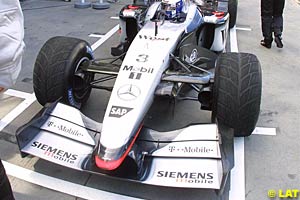 Qualifying started on an almost dry track, but with grey skies threatening, most teams rushed out to get a lap on the timesheets and those who left this "banker" lap late, had a better time than the early runners, as the track warmed up. But with the rain almost upon the circuit, the early runners got their second run in well before the rain, while the later runners lapped on a part wet circuit, effectively ruining their runs. Few drivers ventured out on the fully wet track later in the session.
Qualifying started on an almost dry track, but with grey skies threatening, most teams rushed out to get a lap on the timesheets and those who left this "banker" lap late, had a better time than the early runners, as the track warmed up. But with the rain almost upon the circuit, the early runners got their second run in well before the rain, while the later runners lapped on a part wet circuit, effectively ruining their runs. Few drivers ventured out on the fully wet track later in the session.
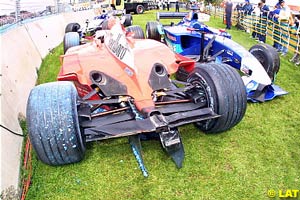 First corner accident
First corner accident
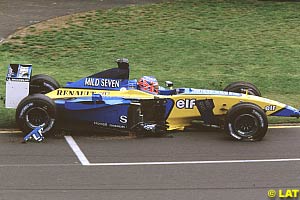 Jenson Button's Renault had its sidepod ripped open, the side impact crash structures being ripped off in the process and a small fire breaking out as some oil caught fire. The Briton still tried to return to the pits, but the car was beyond quick repair. Kimi Raikkonen, however, returned to the pits to get a new nose cone and have some debris removed from his seat, and Mika Salo was able to rejoin after a track rod in his rear suspension was replaced.
Jenson Button's Renault had its sidepod ripped open, the side impact crash structures being ripped off in the process and a small fire breaking out as some oil caught fire. The Briton still tried to return to the pits, but the car was beyond quick repair. Kimi Raikkonen, however, returned to the pits to get a new nose cone and have some debris removed from his seat, and Mika Salo was able to rejoin after a track rod in his rear suspension was replaced.
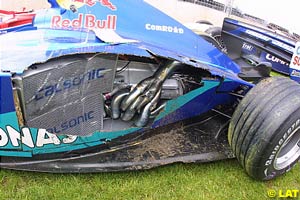 Following on from last year's comparative performance, Michelin struggled in the cooler conditions, while their wet weather tyres drew favourable comments for the drivers. Overall, the Michelin runners were disappointed with the weekend and Bridgestone had the upper hand.
Following on from last year's comparative performance, Michelin struggled in the cooler conditions, while their wet weather tyres drew favourable comments for the drivers. Overall, the Michelin runners were disappointed with the weekend and Bridgestone had the upper hand.
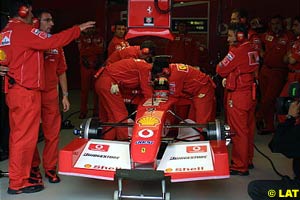 As an example of their superiority, Michael Schumacher set his second postion on the grid on only his first full run (his previous run was aborted) and with used tyres. Later in the session he ran several laps in the wet just to try different lines and test the car's set-up.
As an example of their superiority, Michael Schumacher set his second postion on the grid on only his first full run (his previous run was aborted) and with used tyres. Later in the session he ran several laps in the wet just to try different lines and test the car's set-up.
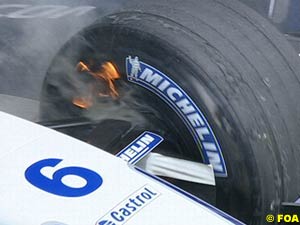 The car also displayed a little understeer, with the aero set-up being tweaked to overcome it. Chief designer Gavin Fisher was unusually present in the pits to oversee the new car's running. Juan Pablo Montoya described driving the car: "I suffered with oversteer in the first session and understeer in the second," and the conditions: "the intermittent rain did not help as the conditions of the track were quickly changing and weren't even consistent over the lap!"
The car also displayed a little understeer, with the aero set-up being tweaked to overcome it. Chief designer Gavin Fisher was unusually present in the pits to oversee the new car's running. Juan Pablo Montoya described driving the car: "I suffered with oversteer in the first session and understeer in the second," and the conditions: "the intermittent rain did not help as the conditions of the track were quickly changing and weren't even consistent over the lap!"
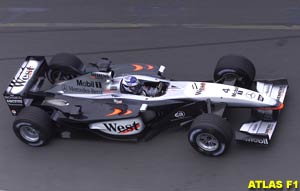 The sidepod's second new feature was a hot air outlet opened up on the extension to the sidepod above the flip up. McLaren have always run a small outlet and supplemented it with chimneys in warmer weather, but this year the downforce from the small winglet on top of the sidepod would be affected by the use of a chimney.
The sidepod's second new feature was a hot air outlet opened up on the extension to the sidepod above the flip up. McLaren have always run a small outlet and supplemented it with chimneys in warmer weather, but this year the downforce from the small winglet on top of the sidepod would be affected by the use of a chimney.
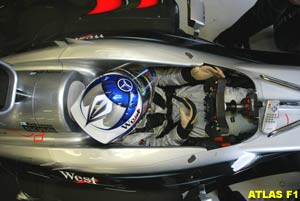 The McLaren gearbox was developed with Mercedes and uses an all new light thin wall alloy casting to save weight. Norbert Haug was proud of the new unit at the launch and explained he would "love to take a photo and show it to everybody!" After the race, Ron Dennis bemoaned the fact that they had "completed 7500 KM of on-track testing" and the gearbox never had a problem...
The McLaren gearbox was developed with Mercedes and uses an all new light thin wall alloy casting to save weight. Norbert Haug was proud of the new unit at the launch and explained he would "love to take a photo and show it to everybody!" After the race, Ron Dennis bemoaned the fact that they had "completed 7500 KM of on-track testing" and the gearbox never had a problem...
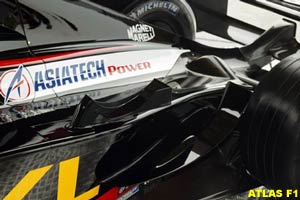 As evident by the team's new found confidence, a new aero development appeared on the car in Melbourne. Minardi ran an additional flip up on the cooling chimney - teams usually drop flip ups in favour of cooling chimneys but Minardi have found a neat workaround to the problem. The rest of the car was in its launch spec, and the car ran the race with a lower downforce, two element rear wing to gain speed on the straights.
As evident by the team's new found confidence, a new aero development appeared on the car in Melbourne. Minardi ran an additional flip up on the cooling chimney - teams usually drop flip ups in favour of cooling chimneys but Minardi have found a neat workaround to the problem. The rest of the car was in its launch spec, and the car ran the race with a lower downforce, two element rear wing to gain speed on the straights.
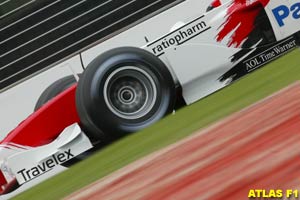 Salo finishing Friday's session sixth was a huge boost, however his one second advantage over his teammate belied the good timing of his runs and problems experienced by Allan McNish. Qualifying didn't produce the same timing and the drivers qualified 0.4s and two positions apart.
Salo finishing Friday's session sixth was a huge boost, however his one second advantage over his teammate belied the good timing of his runs and problems experienced by Allan McNish. Qualifying didn't produce the same timing and the drivers qualified 0.4s and two positions apart.
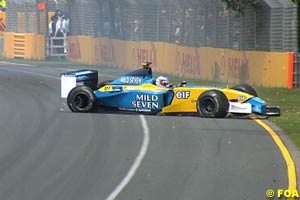 The French engine department produced two spec engines, an "A" and "B" Spec. The "B" spec ran without trouble on Friday and Saturday, but the "A" spec fitted for the race produced little data for the team as engine operations manager Denis Chevrier explains: "The race proved inconclusive in terms of the behaviour of the A-spec engine," as both cars retired early, adding that their race engines had "the lowest mileage of the weekend!"
The French engine department produced two spec engines, an "A" and "B" Spec. The "B" spec ran without trouble on Friday and Saturday, but the "A" spec fitted for the race produced little data for the team as engine operations manager Denis Chevrier explains: "The race proved inconclusive in terms of the behaviour of the A-spec engine," as both cars retired early, adding that their race engines had "the lowest mileage of the weekend!"
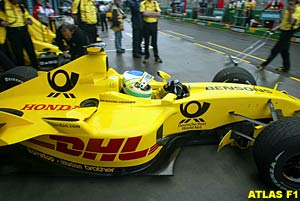 All went well on Friday, both drivers suffering some lost running due to detail problems, but good times were being posted and the drivers were happy. Giancarlo Fisichella continued with small problems on Saturday and crashed out in the first corner incident.
All went well on Friday, both drivers suffering some lost running due to detail problems, but good times were being posted and the drivers were happy. Giancarlo Fisichella continued with small problems on Saturday and crashed out in the first corner incident.
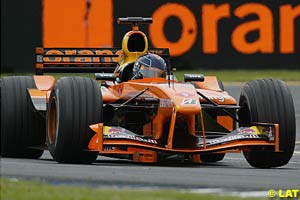 Both cars, however, stalled on the formation grid before the warm-up lap of the race. The same electrical engine problem afflicted both cars and they had to be pushed into the pits. They managed to get Heinz-Harald Frentzen's car running as the race got underway, however he left the pits when the pit exit light was red and was subsequently black flagged for this safety infringement.
Both cars, however, stalled on the formation grid before the warm-up lap of the race. The same electrical engine problem afflicted both cars and they had to be pushed into the pits. They managed to get Heinz-Harald Frentzen's car running as the race got underway, however he left the pits when the pit exit light was red and was subsequently black flagged for this safety infringement.
Please Contact Us for permission to republish this or any other material from Atlas F1.
|
Volume 8, Issue 10
Atlas F1 Exclusive
The Stuff Debuts are Made Of
In the Spotlight: Engine Limitation
GP Review
The 2002 Australian GP Review
Technical Review: Australia
Commentary
The Beggars Rode!
Reflections from Melbourne
Spilt Milk
GP Stats
Qualifying Differentials
2002 SuperStats
The Charts Center
Columns
Season Strokes
Elsewhere in Racing
The Weekly Grapevine
> Homepage |